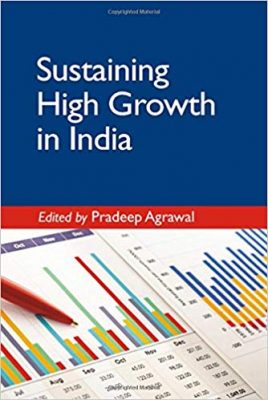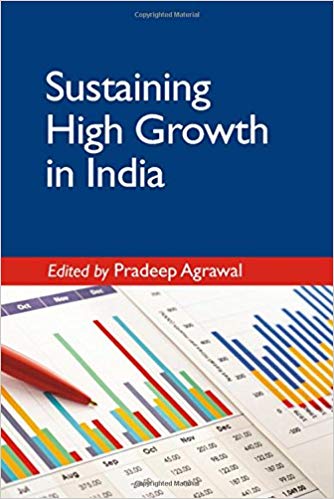 Editor: Pradeep Agrawal
Editor: Pradeep Agrawal
Publisher: Cambridge University Press – 535 pages
Book Review by: Sonu Chandiram
In the October 2019 World Economic Outlook of the International Monetary Fund (IMF) just released on January 01, 2020, India is expected to have a Gross Domestic Product (GDP) per capita of $2,171, ranking No.139 among 186 countries studied. In comparison, you will find the highest income people in Luxembourg, where the average person will have GDP of $113,196 in 2020. The other end of the scale shows the average South Sudanese will have a GDP of just $275.
India’s economy reached a growth rate of 9 percent in 2010, but slowed down to just 5 percent in the 2012-2014 period. In 2018, the IMF points out, India’s GDP growth rate increased to 7.0 percent, maintaining that rate in 2019. In 2020, it will go up to 7.2 percent, the IMF estimates.
Pradeep Agrawal informs us that in order to eliminate its poverty and reach ‘decent standards’ of living, India must have a growth rate of at least 8 percent for the next 20 years.
The economic factors that prevent a sustained growth of eight percent or more are the following, in alphabetical order: demography, governance, human capital, industrial policy, inflation, infrastructure bottlenecks, and trade policy.
These issues are addressed and discussed in this book. Other factors that impinge upon India’s economic growth are: the Euro-zone debt crisis, the mega Free Trade Agreement (FTA), and the Foreign Direct Investment (FDI) and the Foreign Portfolio Investment (FPI) policies of India.
Inflation in particular, and as a consequence, the high interest rate needed to combat it, has been huge obstacles to sustaining a high growth rate of the Gross Domestic Product (GDP) for India. A huge population also makes the task quite difficult: the population of India is 1,373,307,251 as of Thursday, January 2, 2020, based on Worldometers’ elaboration of the latest United Nations data.
Twenty-seven specialists in economic development and growth from all over India and four other countries – Italy, New Zealand, the United Kingdom, and the United States – authored the 16 chapters of this book, as listed below:
Introduction
- Section 1 – Ensuring Macroeconomic Stability for Sustaining High Growth Rates
- Propagation Mechanisms of Inflation in India: An Empirical investigation
- Managing Food Price Inflation in India: Demand Projections and Supply Considerations
- Section 2 – Promoting Industrial Development for Sustaining High Growth Rates
- Economic Complexity as a Determinant of Industrialization of Countries: The Case of India
- China’s Manufacturing Success: Lessons for India
- Sustaining India’s Manufacturing Sector Growth in the Face of Increasing Competition from Chinese Imports
- Section 3 – International Economic Issues and Sustaining High Growth
- Global Recession and the Euro-zone Debt Crisis: Impact on Exports of India and China
- Changing Global Trade Regime and Emergence of Mega FTAs: Strategy for India’s External Sector Sustainability
- Economic Impact of Foreign Capital Inflows in Emerging Asia
- FDI Outflows from the e BRIC Countries: Impact on Domestic Capital Formation
- Section 4 – Infrastructure Bottlenecks to Sustaining High Growth
- Infrastructure, Human Capital, and Economic Growth: A Quantitative Analysis for India
- Elementary Education for India: A Study of Accessibility and Quality
- Education and Economic Growth: A Comparative Study of China and India
- Section 5 – Some Socio-political Issues in Sustaining High Growth
- Demographic Dividend and Economic Growth in India and China
- Does Social Cohesion Limit Uncertainties in Economic Growth? A Pre- and Post-reform Analysis from India
- Does Openness and Democracy Reduce Corruption? Results for South Asian Nations and India
- Regional Dynamics of Rural Credit and growth in India: Exploring Nonlinearity and Convergence in Growth Patterns
This book takes a broad look at the ways India can achieve a high rate of economic development and growth and maintain it on a sustained basis.
Editor:
Pradeep Agrawal passed away on May 17, 2017. His sudden and untimely death has come as a rude shock to the academic community which lost an experienced scholar, whose contribution to economic research and policy has been substantial and significant for the last 30 years.
After a doctorate in economics from Stanford University in 1987, Professor Agrawal continued his academic career in the United States until 1990 as faculty at the University of Nebraska, Illinois State University, and Texas Tech University. In 1990, he joined the Indira Gandhi Institute of Development Research (IGIDR) n Mumbai as a senior faculty and continued until 2000. He then joined in 2000, the Institute of Economic Growth (IEG) in New Delhi as professor and head of the Reserve Bank of India (RBI) unit and worked there until 2017.
In a career spanning more than 30 years, Professor Agrawal made significant theoretical and practical contributions to economics, particularly in the areas of agricultural economics, economic growth and development, economic reforms, international economics, and macroeconomics. His work varied across different themes, mostly focusing on contemporary relevant economic issues that mattered at that time.
In the last 15 years, he focused his research to answer some of the contemporary policy issues relating to India’s economy in the field of applied economics, such as the interest-rate savings relationship, optimal rate of interest for India, energy security, financial sector reforms, determinants of exports, and other issues. Some of his work on the determinants of savings and the savings-growth nexus are a good contribution to literature.
Out of his concern for India’s slowing growth during the past global financial crisis, he brought together reputable scholars to edit a volume entitled Reviving Growth in India, published by Cambridge University Press in 2015, He was a very simple soul who had convictions on issues, both academic and administrative. His untimely death is a huge loss to the academic community.







